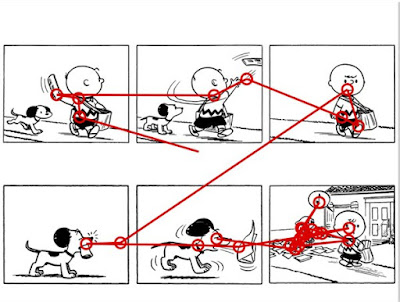New paper: Reading without words
One of the most frequent questions that people ask about reading comics is “what are people’s eyes doing when comprehending comics?” More and more, I see people planning eye-tracking experiments with comics where eyes are recorded for where they move across a page or strip. I’ve reviewed a number of these studies on this blog, and many use fairly ad hoc methods without systematically manipulating elements within the experiment.
I’m very proud to say that my new paper, “Reading without words: Eye-movements in the comprehending of comic strips,” with Tom Foulsham and Dean Wybrow in the journal Applied Cognitive Psychology, addresses these very issues. I was very happy to collaborate with Tom on this project, and it should be the first of several papers related to eye-tracking that we will produce. To our knowledge, this is the first paper on eye-tracking of comics that systematically manipulates aspects of the sequences in controlled experiments outside of free-form reading or without resorting to post-hoc alterations.
We did two experiments where participants read Peanuts comics in either a coherent or scrambled sequence. In Experiment 1, participants were presented with each panel one-at-a-time, while Experiment 2 presented them in a 3×2 grid. Overall, we found that people had more dispersed eye-movements for the scrambled strips, which also created more “regressions” (looks backward) to other panels in the sequence. This study also addressed a few myths of how comics are understood:
1) By and large, reading order in the 3×2 grid resembled that of text—a left-to-right and down motion with regressions to adjacent units. There was no “scanning” of the page prior to reading, as some have claimed.
2) We also found no real difference in eye-movements for the content of panels between layouts. That is, changing the layout did not affect the comprehension of the sequence.
You can download the paper on my Downloadable Papers page or click here for a pdf.
Here’s the full abstract:
“The study of attention in pictures is mostly limited to individual images. When we ‘read’ a visual narrative (e.g., a comic strip), the pictures have a coherent sequence, but it is not known how this affects attention. In two experiments, we eyetracked participants in order to investigate how disrupting the visual sequence of a comic strip would affect attention. Both when panels were presented one at a time (Experiment 1) and when a sequence was presented all together (Experiment 2), pictures were understood more quickly and with fewer fixations when in their original order. When order was randomised, the same pictures required more attention and additional ‘regressions’. Fixation distributions also differed when the narrative was intact, showing that context affects where we look. This reveals the role of top-down structures when we attend to pictorial information, as well as providing a springboard for applied research into attention within image sequences.”
Foulsham, Tom, Dean Wybrow, and Neil Cohn. (2016) Reading Without Words: Eye Movements in the Comprehension of Comic Strips. Applied Cognitive Psychology. 30: 566-579

Comments